Evolution and Attribution of Flood Volume in the Source Region of the Yellow River
Abstract
1. Introduction
2. Materials and Methods
2.1. Study Area
2.2. Data
2.2.1. Observation Data
2.2.2. Gridded Data
2.3. Methods
2.3.1. Calculation of Flood Volume
2.3.2. Linear Regression Analysis
2.3.3. Water Balance and the Budyko Framework at Flood Seasonal Scale
2.3.4. Establish the Relationship Between Vegetation Index, Active Layer Thickness, and Parameter n
2.3.5. Attribution Analysis of Flood Volume
3. Results
3.1. Variation in the Long-Time Flood Volume
3.2. Spatiotemporal Variations in Precipitation, Potential Evapotranspiration, and Water Storage Change During the Flood Season
3.3. Sensitivity Analysis of Flood Volume to Influencing Factors
3.4. Contributions of Climatic and Landscape Factors to Flood Volume Variation
4. Discussion
4.1. Impact of Vegetation Change on Flood Volume Variation
4.2. Impact of Permafrost Degradation on Flood Volume
4.3. Uncertainties
5. Conclusions
- (1)
- Flood volume exhibited a downward trend before 2000, followed by a significant upward trend after 2000 in all basins. Compared to the average flood volume before 2000, the average flood volume since 2000 was reduced.
- (2)
- Flood volume was more sensitive to changes in precipitation, followed by landscape change.
- (3)
- The estimated flood volume variation based on the Budyko framework can explain 99% of the observed flood volume variation, further indicating the robustness of the method used in this study.
- (4)
- In permafrost-dominated basins, flood volume variation was primarily affected by changes in active layer thickness, with relative contributions ranging from −56.2% to −42%, followed by changes in precipitation. In non-permafrost-dominated basins, the decrease in flood volume was primarily attributed to changes in landscape. The regulating effect of vegetation was greater in non-permafrost-dominated basins than in permafrost-dominated basins.
Supplementary Materials
Author Contributions
Funding
Data Availability Statement
Acknowledgments
Conflicts of Interest
References
- Hallegatte, S.; Vogt-Schilb, A.; Bangalore, M.; Rozenberg, J. Unbreakable: Building the Resilience of the Poor in the Face of Natural Disasters (English); World Bank Group: Washington, DC, USA, 2017. [Google Scholar]
- McDermott, T.K.J. Global exposure to flood risk and poverty. Nat. Commun. 2022, 13, 3529. [Google Scholar] [CrossRef] [PubMed]
- Wahlstrom, M.; Guha-Sapir, D. The Human Cost of Weather-Related Disasters 1995–2015; UNISDR: Geneva, Switzerland, 2015; pp. 7–11. [Google Scholar]
- Intergovernmental Panel on Climate Change (IPCC). Climate Change 2021—The Physical Science Basis: Working Group I Contribution to the Sixth Assessment Report of the Intergovernmental Panel on Climate Change, 1st ed.; Cambridge University Press: Cambridge, UK, 2023; ISBN 978-1-00-915789-6. [Google Scholar]
- Hu, P.; Zhang, Q.; Shi, P.; Chen, B.; Fang, J. Flood-induced mortality across the globe: Spatiotemporal pattern and influencing factors. Sci. Total Environ. 2018, 643, 171–182. [Google Scholar] [CrossRef] [PubMed]
- Wang, Y.; Wang, S.; Wang, L.; Guo, X.; Zhou, J.; Chai, C.; Xu, J.; Li, X.; Fan, M.; Wang, S.; et al. Temporal and spatial changes in hydrological wet extremes of the largest river basin on the Tibetan Plateau. Environ. Res. Lett. 2023, 18, 104006. [Google Scholar] [CrossRef]
- Lan, H.; Zhao, Z.; Li, L.; Li, J.; Fu, B.; Tian, N.; Lai, R.; Zhou, S.; Zhu, Y.; Zhang, F.; et al. Climate change drives flooding risk increases in the Yellow River Basin. Geogr. Sustain. 2024, 5, 193–199. [Google Scholar] [CrossRef]
- Tellman, B.; Sullivan, J.A.; Kuhn, C.; Kettner, A.J.; Doyle, C.S.; Brakenridge, G.R.; Erickson, T.A.; Slayback, D.A. Satellite imaging reveals increased proportion of population exposed to floods. Nature 2021, 596, 80–86. [Google Scholar] [CrossRef]
- Alifu, H.; Hirabayashi, Y.; Imada, Y.; Shiogama, H. Enhancement of river flooding due to global warming. Sci. Rep. 2022, 12, 20687. [Google Scholar] [CrossRef]
- Blöschl, G.; Hall, J.; Parajka, J.; Perdigão, R.A.P.; Merz, B.; Arheimer, B.; Aronica, G.; Bilibashi, A.; Bonacci, O.; Borga, M.; et al. Changing climate shifts timing of European floods. Science 2017, 357, 588–590. [Google Scholar] [CrossRef]
- Blöschl, G.; Hall, J.; Viglione, A.; Perdigão, R.A.; Parajka, J.; Merz, B.; Lun, D.; Arheimer, B.; Aronica, G.; Bilibashi, A.; et al. Changing climate both increases and decreases European river floods. Nature 2019, 573, 108–111. [Google Scholar] [CrossRef]
- Do, H.X.; Westra, S.; Leonard, M.A. A global-scale investigation of trends in annual maximum streamflow. J. Hydrol. 2017, 552, 28–43. [Google Scholar] [CrossRef]
- Shin, S.; Pokhrel, Y.; Yamazaki, D.; Huang, X.; Torbick, N.; Qi, J.; Pattanakiat, S.; Ngo-Duc, T.; Nguyen, T.D. High resolution modeling of River-floodplain-reservoir inundation dynamics in the Mekong River Basin. Water Resour. Res. 2020, 56, e2019WR026449. [Google Scholar] [CrossRef]
- Wang, X.; Chen, D.; Pang, G.; Gou, X.; Yang, M. Historical and Future Climates over the Upper and Middle Reaches of the Yellow River Basin Simulated by a Regional Climate Model in CORDEX. Clim. Dyn. 2021, 56, 2749–2771. [Google Scholar] [CrossRef]
- Luo, D.; Jin, H.; Bense, V.F.; Jin, X.; Li, X. Hydrothermal processes of near-surface warm permafrost in response to strong precipitation events in the Headwater Area of the Yellow River, Tibetan Plateau. Geoderma 2020, 376, 114531. [Google Scholar] [CrossRef]
- Wang, T.; Yang, H.; Yang, D.; Qin, Y.; Wang, Y. Quantifying the streamflow response to frozen ground degradation in the source region of the Yellow River within the Budyko framework. J. Hydrol. 2018, 558, 301–313. [Google Scholar] [CrossRef]
- Zhang, T.; Li, D.; Lu, X. Response of runoff components to climate change in the source-region of the Yellow River on the Tibetan plateau. Hydrol. Process. 2022, 36, e14633. [Google Scholar] [CrossRef]
- Li, Z.; Lyu, S.; Chen, H.; Ao, Y.; Zhao, L.; Wang, S.; Zhang, S.; Meng, X. Changes in climate and snow cover and their synergistic influence on spring runoff in the source region of the Yellow River. Sci. Total Environ. 2021, 799, 149503. [Google Scholar] [CrossRef]
- Qin, Y.; Yang, D.; Gao, B.; Wang, T.; Chen, J.; Chen, Y.; Wang, Y.; Zheng, G. Impacts of climate warming on the frozen ground and eco-hydrology in the Yellow River source region, China. Sci. Total Environ. 2017, 605–606, 830–841. [Google Scholar] [CrossRef]
- Wang, W.; Zhang, Y.; Geng, X.; Tang, Q. Impact classification of future land use and climate changes on flow regimes in the Yellow River Source Region, China. J. Geophys. Res. Atmos. 2021, 126, e2020JD034064. [Google Scholar] [CrossRef]
- Meng, F.; Su, F.; Yang, D.; Tong, K.; Hao, Z. Impacts of recent climate change on the hydrology in the source region of the Yellow River basin. J. Hydrol. Reg. Stud. 2016, 6, 66–81. [Google Scholar] [CrossRef]
- Song, W.; Liu, H.; Cui, P.; Xu, M. Analysis of the characteristics of medium and small floods and reservoir operation in the Upper reaches of the Yellow River in recent years. Yellow River 2020, 42, 34–39. (In Chinese) [Google Scholar]
- Chu, C.; Ren, L. Analysis of the characteristics of floods in 2018 in the Source region of the Yellow River. Yellow River 2020, 42 (Suppl. S2), 14–16. (In Chinese) [Google Scholar]
- Yang, J.; Wang, T.; Yang, D.; Yang, Y. Insights into runoff changes in the source region of Yellow River under frozen ground degradation. J. Hydrol. 2023, 617, 128892. [Google Scholar] [CrossRef]
- Iqbal, M.; Wen, J.; Masood, M.; Masood, M.U.; Adnan, M. Impacts of Climate and Land-Use Changes on Hydrological Processes of the Source Region of Yellow River, China. Sustainability 2022, 14, 14908. [Google Scholar] [CrossRef]
- Sun, L.; Li, T.; Li, Q.; Wu, Y. Responses of autumn flood peak in the Yellow River source regions to westerly circulation index. J. Glaciol. Geocryol. 2019, 41, 1475–1482. (In Chinese) [Google Scholar]
- Yuan, F.; Wang, B.; Shi, C.; Cui, W.; Zhao, C.; Liu, Y.; Ren, L.; Zhang, L.; Zhu, Y.; Chen, T.; et al. Evaluation of hydrological utility of IMERG Final run V05 and TMPA 3B42V7 satellite precipitation products in the Yellow River source region, China. J. Hydrol. 2018, 567, 696–711. [Google Scholar] [CrossRef]
- Ni, Y.; Lv, X.; Yu, Z.; Wang, J.; Ma, L.; Zhang, Q. Intra-annual variation in the attribution of runoff evolution in the Yellow River source area. Catena 2023, 225, 107032. [Google Scholar] [CrossRef]
- Chang, Y.; Ding, Y.; Zhang, S.; Zhao, Q.; Jin, Z.; Qin, J.; Shangguan, D. Quantifying the response of runoff to glacier shrinkage and permafrost degradation in a typical cryospheric basin on the Tibetan Plateau. Catena 2024, 242, 108124. [Google Scholar] [CrossRef]
- Ji, G.; Wu, L.; Wang, L.; Yan, D.; Lai, Z. Attribution Analysis of Seasonal Runoff in the Source Region of the Yellow River Using Seasonal Budyko Hypothesis. Land 2021, 10, 542. [Google Scholar] [CrossRef]
- Jin, X.; Jin, H.; Luo, D.; Sheng, Y.; Wu, Q.; Wu, J.; Wang, W.; Huang, S.; Li, X.; Liang, S.; et al. Impacts of Permafrost Degradation on Hydrology and Vegetation in the Source Area of the Yellow River on Northeastern Qinghai-Tibet Plateau, Southwest China. Front. Earth Sci. 2022, 10, 845824. [Google Scholar] [CrossRef]
- Ma, L.; Liu, Z.; Zhao, B.; Lyu, J.; Zheng, F.; Xu, W.; Gan, X. Variations of runoff and sediment and their response to human activities in the source region of the Yellow River, China. Environ. Earth Sci. 2021, 80, 552. [Google Scholar] [CrossRef]
- Zeng, B.; Zhang, F.; Zeng, W.; Yan, K.; Cui, C. Spatiotemporal heterogeneity in runoff dynamics and its drivers in a water conservation area of the upper Yellow River Basin over the past 35 years. Remote Sens. 2022, 14, 3628. [Google Scholar] [CrossRef]
- Zhang, Y.; Ye, A. Quantitatively distinguishing the impact of climate change and human activities on vegetation in mainland China with the improved residual method. Gisci. Remote Sens. 2021, 58, 235–260. [Google Scholar] [CrossRef]
- Yan, D.; Zheng, X.; Feng, M.; Liang, S.; Hu, Z.; Kuang, X.; Feng, Y. Frozen Ground Change Data Set in the Tibetan Plateau (1961–2020); National Tibetan Plateau/Third Pole Environment Data Center. 2023. Available online: https://data.tpdc.ac.cn/en/data/e03ae441-0af2-4f57-b5b0-0a4f368f4015 (accessed on 10 March 2024).
- He, J.; Yang, K.; Tang, W.; Lu, H.; Qin, J.; Chen, Y.; Li, X. The first high-resolution meteorological forcing dataset for land process studies over China. Sci. Data 2020, 7, 25. [Google Scholar] [CrossRef] [PubMed]
- Wu, J.; Gao, X. A gridded daily observation dataset over China region and comparison with the other datasets. Chin. J. Geophys. 2013, 56, 1102–1111. (In Chinese) [Google Scholar]
- Wu, X.; Su, J.; Ren, W.; Lü, H.; Yuan, F. Statistical comparison and hydrological utility evaluation of ERA5-Land and IMERG precipitation products on the Tibetan Plateau. J. Hydrol. 2023, 620, 129384. [Google Scholar] [CrossRef]
- Yang, K.; Jiang, Y.; Tang, W.; He, J.; Shao, C.; Zhou, X.; Lu, H.; Chen, Y.; Li, X.; Shi, J. A high-resolution near-surface meteorological forcing dataset for the Third Pole region (TPMFD, 1979–2022); National Tibetan Plateau/Third Pole Environment Data Center. 2023. Available online: https://data.tpdc.ac.cn/en/data/44a449ce-e660-44c3-bbf2-31ef7d716ec7 (accessed on 10 March 2024).
- Jiang, Y.; Yang, K.; Qi, Y.; Zhou, X.; He, J.; Lu, H.; Li, X.; Chen, Y.; Li, X.; Zhou, B.; et al. TPHiPr: A long-term (1979–2020) high-accuracy precipitation dataset (1/30°, daily) for the Third Pole region based on high-resolution atmospheric modeling and dense observations. Earth Syst. Sci. Data 2023, 15, 621–638. [Google Scholar] [CrossRef]
- Muñoz, J. ERA5-Land Hourly Data from 1981 to Present—Copernicus Climate Change Service (C3S) Climate Data Store (CDS). 2019. Available online: https://cds.climate.copernicus.eu/datasets/reanalysis-era5-land?tab=download (accessed on 10 March 2024).
- Pelosi, A.; Terribile, F.; Urso, G.D. Comparison of ERA5-Land and UERRA MESCAN-SURFEX Reanalysis Data with Spatially Interpolated Weather Observations for the Regional Assessment of Reference Evapotranspiration. Water 2020, 12, 1669. [Google Scholar] [CrossRef]
- Gourgouletis, N.; Gkavrou, M.; Baltas, E. Comparison of Empirical ET0 Relationships with ERA5-Land and In Situ Data in Greece. Geographies 2023, 3, 499–521. [Google Scholar] [CrossRef]
- Li, F.; Kusche, J.; Chao, N.; Wang, Z.; Löcher, A. Long-term (1979-present) Total Water Storage Anomalies Over the Global Land Derived by Reconstructing GRACE data. Geophys. Res. Lett. 2021, 48, e2021GL093492. [Google Scholar] [CrossRef]
- Zhou, X.; Sheng, Z.; Manevksi, K.; Zhao, R.; Zhang, Q.; Yang, Y.; Han, S.; Liu, J.; Yang, Y. Can system dynamics explain long-term hydrological behaviors? The role of endogenous linking structure. Hydrol. Earth Syst. Sci. 2025, 29, 159–177. [Google Scholar] [CrossRef]
- Wei, L.; Zhao, W.; Wu, C.; Feng, X.; Song, D. Identification of dominant drivers of streamflow spatiotemporal variations in typical mountainous areas in the Hexi Corridor, China. J. Hydrol. Reg. Stud. 2024, 56, 102024. [Google Scholar] [CrossRef]
- Cao, S.; Li, M.; Zhu, Z.; Wang, Z.; Zha, J.; Zhao, W.; Duanmu, Z.; Chen, J.; Zheng, Y.; Chen, Y.; et al. Spatiotemporally consistent global dataset of the GIMMS Leaf Area Index (GIMMS LAI4g) from 1982 to 2020. Earth Syst. Sci. Data 2023, 15, 4877–4899. [Google Scholar] [CrossRef]
- Sun, S.; Bi, Z.; Mu, M.; Liu, Y.; Zhang, Y.; Li, J.; Liu, Y.; Zhou, Y.; Zhou, B.; Chen, H. Quantifying impacts of vegetation greenness change on drought over global vegetation zones. Geophys. Res. Lett. 2025, 52, e2024GL111634. [Google Scholar] [CrossRef]
- Wu, C.; Yeh, P.J.-F.; Yao, T.; Gong, Z.; Niu, J.; Yuan, S. Controls of climate seasonality and vegetation dynamics on the seasonal variability of terrestrial water storage under diverse climate regimes. Water Resour. Res. 2025, 61, e2024WR038065. [Google Scholar] [CrossRef]
- Chang, Y.; Ding, Y.; Zhang, S.; Shangguan, D.; Qin, J.; Zhao, Q. Contribution of climatic variables and their interactions to reference evapotranspiration changes considering freeze-thaw cycles in the Tibetan Plateau during 1960–2022. Atmos. Res. 2024, 305, 107425. [Google Scholar] [CrossRef]
- Ning, T.; Li, Z.; Feng, Q.; Li, Z.; Qin, Y. Attribution of growing season evapotranspiration variability considering snowmelt and vegetation changes in the arid alpine basins. Hydrol. Earth Syst. Sci. 2021, 25, 3455–3469. [Google Scholar] [CrossRef]
- Liu, J.; Zhang, Q.; Feng, S.; Gu, X.; Singh, V.P.; Sun, P. Global Attribution of Runoff Variance Across Multiple Timescales. J. Geophys. Res. Atmos. 2019, 124, 13962–13974. [Google Scholar] [CrossRef]
- Budyko, M.I. Climate and Life; Academic Press: New York, NY, USA, 1974. [Google Scholar]
- Fu, B.P. On the calculation of the evaporation from land surface. Chin. J. Atmos. Sci. 1981, 5, 23–31. (In Chinese) [Google Scholar]
- Zhou, G.; Wei, X.; Chen, X.; Zhou, P.; Liu, X.; Xiao, Y.; Sun, G.; Scott, D.F.; Zhou, S.; Han, L.; et al. Global pattern for the effect of climate and land cover on water yield. Nat. Commun. 2015, 6, 5918. [Google Scholar] [CrossRef]
- Yang, L.; Feng, Q.; Ning, T.; Lu, X.; Zhu, M.; Yin, X.; Wang, J. Attributing the streamflow variation by incorporating glacier mass balance and frozen ground into the Budyko framework in alpine rivers. J. Hydrol. 2024, 628, 130438. [Google Scholar] [CrossRef]
- Iqbal, M.; Wen, J.; Wang, X.; Lan, Y.; Tian, H.; Anjum, M.N.; Adnan, M. Assessment of air temperature trends in the source region of yellow river and its sub-basins, China. Asia-Pac. J. Atmos. Sci. 2018, 54, 111–123. [Google Scholar] [CrossRef]
- Zheng, Z.; Lv, M.; Ma, Z. Climate, hydrology, and vegetation coverage changes in source region of yellow river and countermeasures for challenges. Bull. Chin. Acad. Sci. 2020, 35, 61–72. [Google Scholar]
- Wang, Y.; Wang, L.; Zhou, J.; Chai, C.; Hu, Z.; Zhao, L.; Wang, S.; Fan, M. Impacts of frozen ground degradation and vegetation greening on upper Brahmaputra runoff during 1981–2019. Int. J. Climatol. 2023, 43, 3768–3781. [Google Scholar] [CrossRef]
- Cao, H.; Gao, B.; Gong, T.; Wang, B. Analyzing Changes in Frozen Soil in the Source Region of the Yellow River Using the MODIS Land Surface Temperature Products. Remote Sens. 2021, 13, 180. [Google Scholar] [CrossRef]
- Wang, T.; Yang, D.; Yang, Y.; Zheng, G.; Jin, H.; Li, X.; Yao, T.; Cheng, G. Pervasive permafrost thaw exacerbates future risk of water shortage across the Tibetan Plateau. Earth’s Future 2023, 11, e2022EF003463. [Google Scholar] [CrossRef]
- Wang, T.; Yang, D.; Yang, Y.; Zheng, G.; Jin, H.; Li, X.; Yao, T.; Cheng, G. Unsustainable water supply from thawing permafrost on the Tibetan Plateau in a changing climate. Sci. Bull. 2023, 68, 1105–1108. [Google Scholar] [CrossRef]
- Zhao, Y.; Yao, Y.; Jin, H.; Cao, B.; Hu, Y.; Ran, Y.; Zhang, Y. Characterizing the changes in permafrost thickness across Tibetan Plateau. Remote Sens. 2023, 15, 206. [Google Scholar] [CrossRef]
- Duan, L.; Man, X.; Kurylyk, B.L.; Cai, T.; Li, Q. Distinguishing streamflow trends caused by changes in climate, forest cover, and permafrost in a large watershed in northeastern China. Hydrol. Process. 2017, 31, 1938–1951. [Google Scholar] [CrossRef]
- Munoz, S.E.; Giosan, L.; Therrell, M.D.; Remo, J.W.; Shen, Z.; Sullivan, R.M.; Wiman, C.; O’Donnell, M.; Donnelly, J.P. Climatic control of Mississippi River flood hazard amplified by river engineering. Nature 2018, 556, 95–98. [Google Scholar] [CrossRef]
- Ning, T.; Li, Z.; Liu, W. Vegetation dynamics and climate seasonality jointly control the interannual catchment water balance in the Loess Plateau under the Budyko framework. Hydrol. Earth Syst. Sci. 2017, 21, 1515–1526. [Google Scholar] [CrossRef]
- Lü, A.; Jia, S.; Zhu, W.; Yan, H.; Duan, S.; Yao, Z. El Niño-Southern Oscillation and water resources in the headwaters region of the Yellow River: Links and potential for forecasting. Hydrol. Earth Syst. Sci. 2011, 15, 1273–1281. [Google Scholar] [CrossRef]
- Nalley, D.; Adamowski, J.; Biswas, A.; Gharabaghi, B.; Hu, W. A multiscale and multivariate analysis of precipitation and streamflow variability in relation to ENSO, NAO and PDO. J. Hydrol. 2019, 574, 288–307. [Google Scholar] [CrossRef]
- Xu, R.; Qiu, D.; Gao, P.; Wu, C.; Mu, X.; Ismail, M. Prediction of streamflow based on the long-term response of streamflow to climatic factors in the source region of the Yellow River. J. Hydrol. Reg. Stud. 2024, 52, 101681. [Google Scholar] [CrossRef]
- Yang, T.; Asanjan, A.A.; Welles, E.; Gao, X.; Sorooshian, S.; Liu, X. Developing reservoir monthly inflow forecasts using artificial intelligence and climate phenomenon in formation. Water Resour. Res. 2017, 53, 2786–2812. [Google Scholar] [CrossRef]
- Lü, A.; Jia, S.; Wang, S.; Yan, H.; Yang, G. Relationship between streamflow and the indices of ENSO and PDO. South-North Transf. Water Sci. Technol. 2010, 8, 49–52. (In Chinese) [Google Scholar]
- Wang, H.; Li, D.; Jiang, Y. Characteristics and reasons of the runoff variation in source regions of the Yellow River during 1956–2012. J. Glaciol. Geocryol. 2014, 36, 403–412. (In Chinese) [Google Scholar]


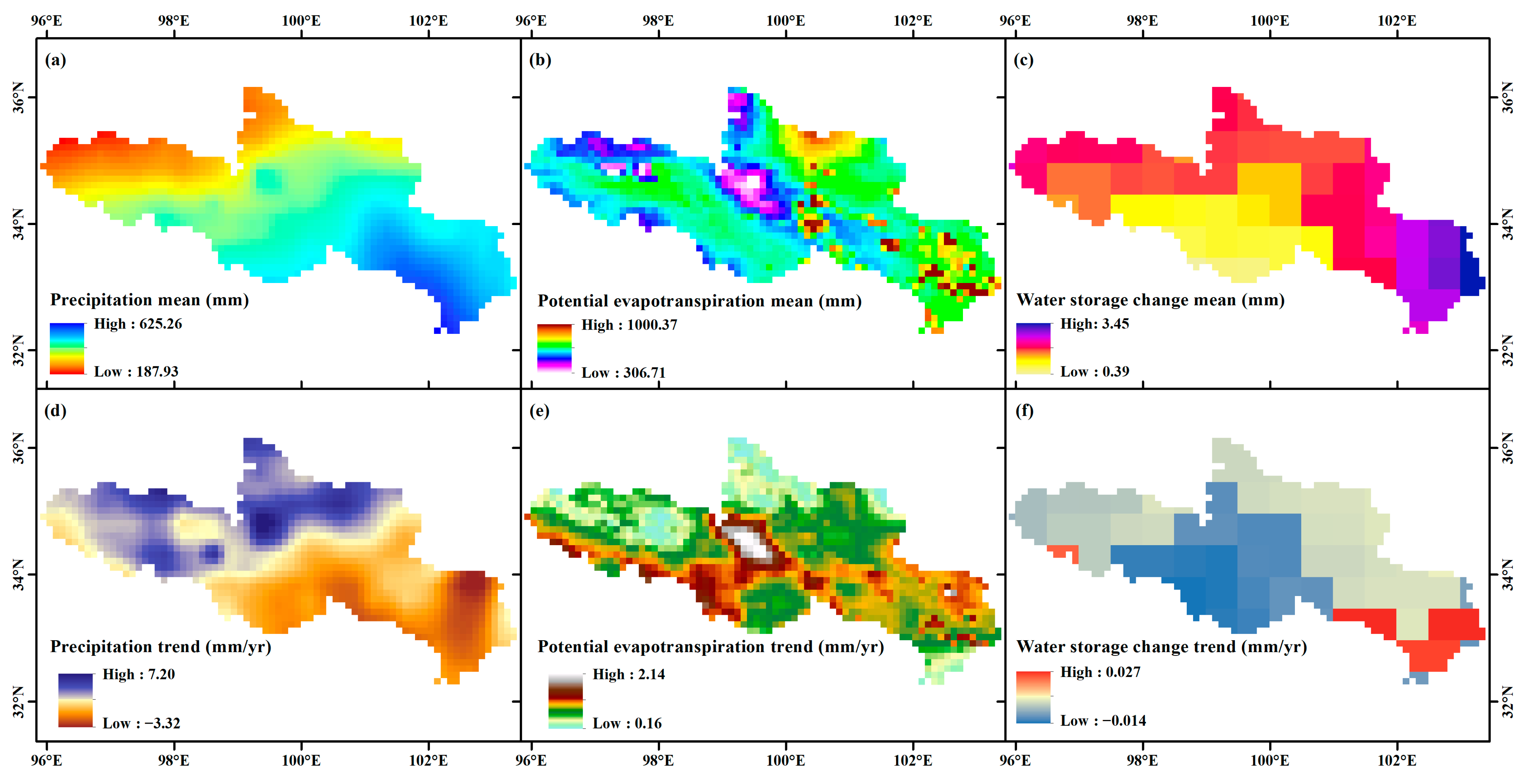
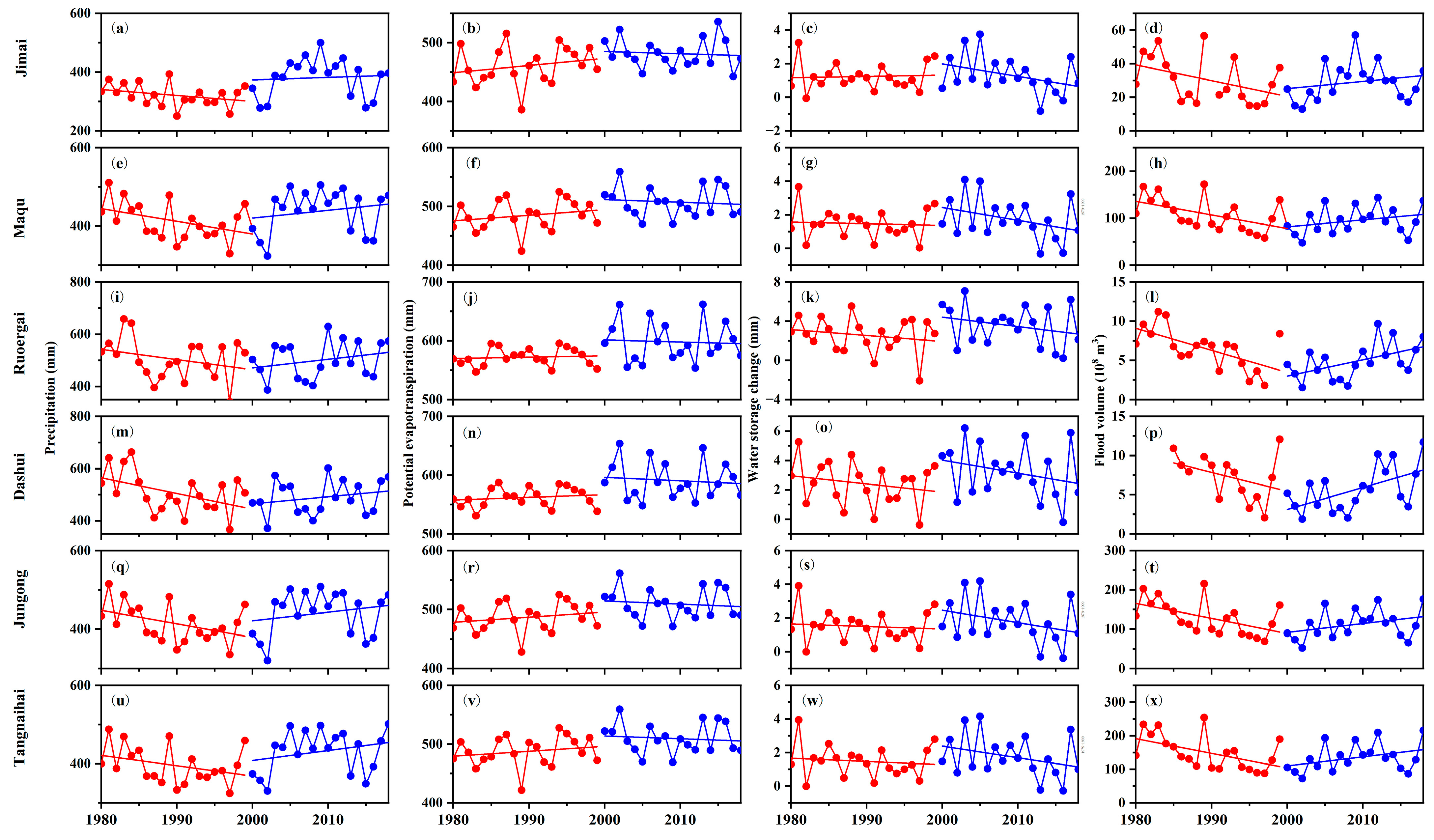
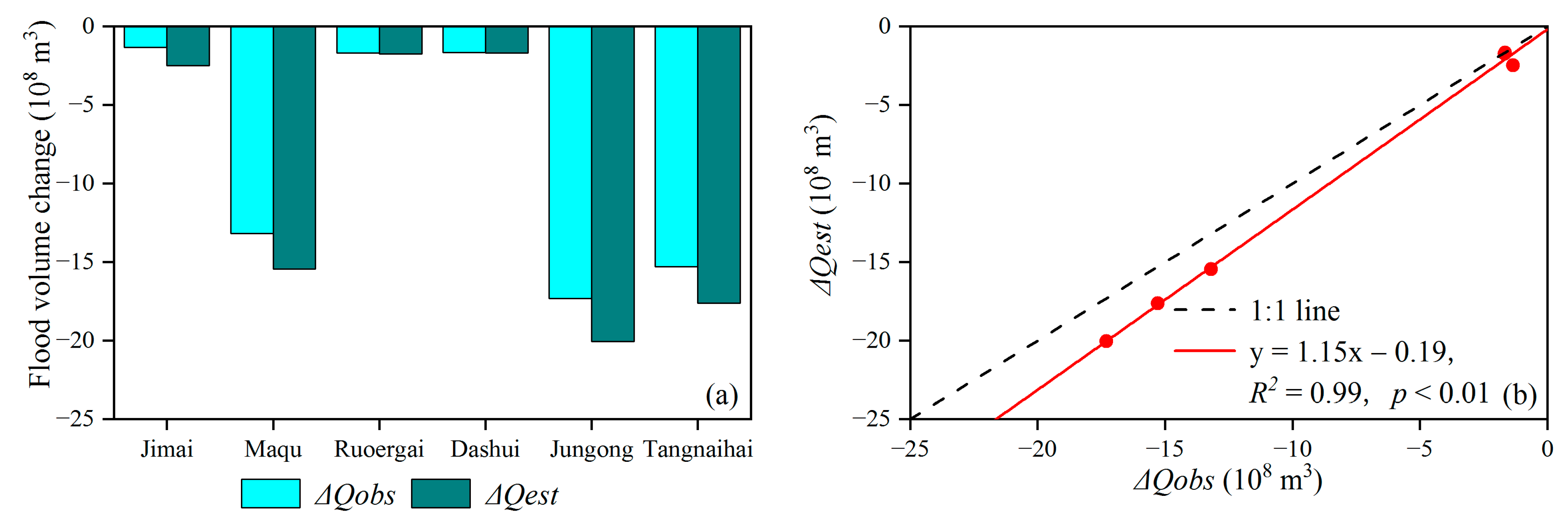
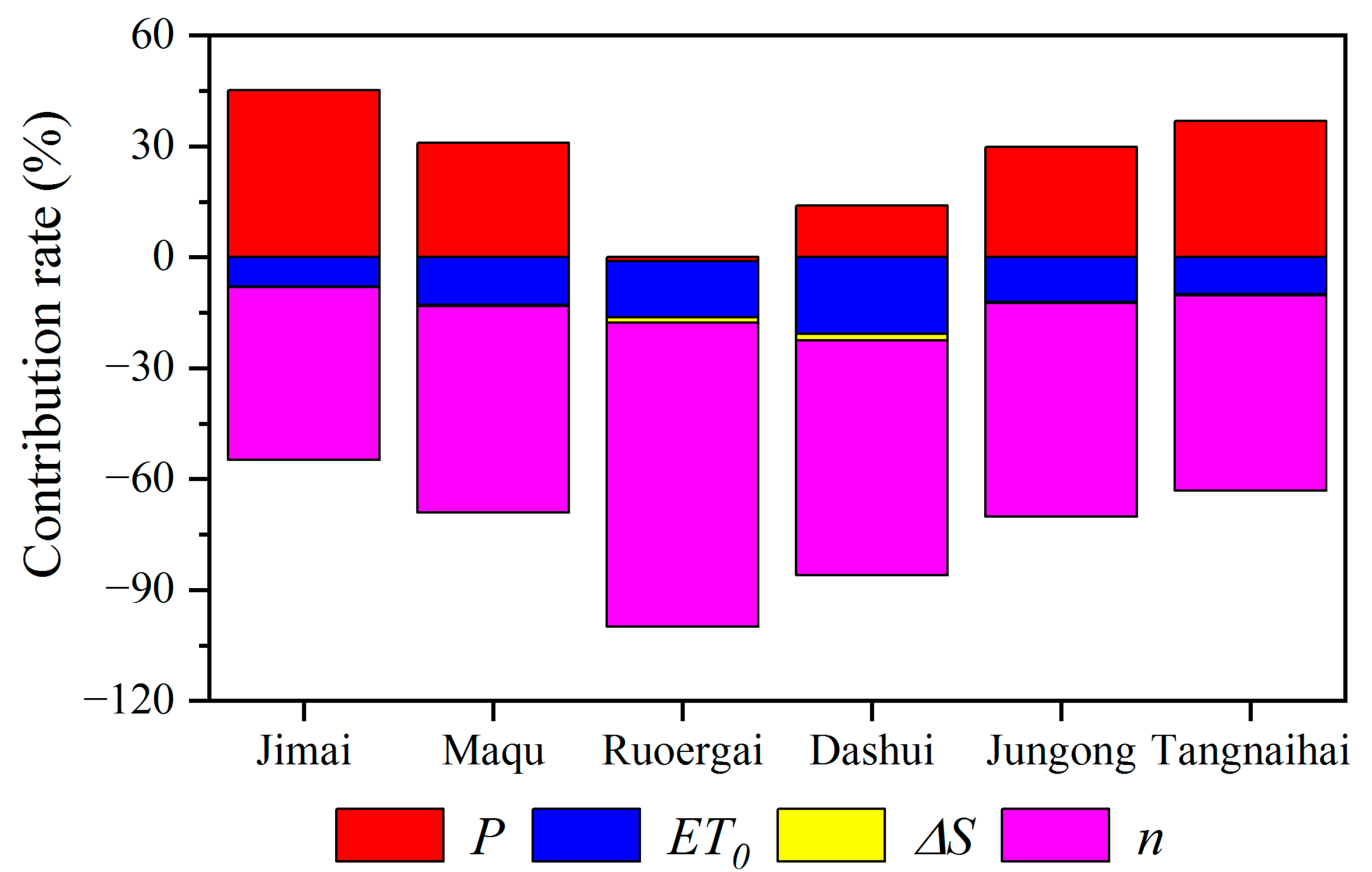
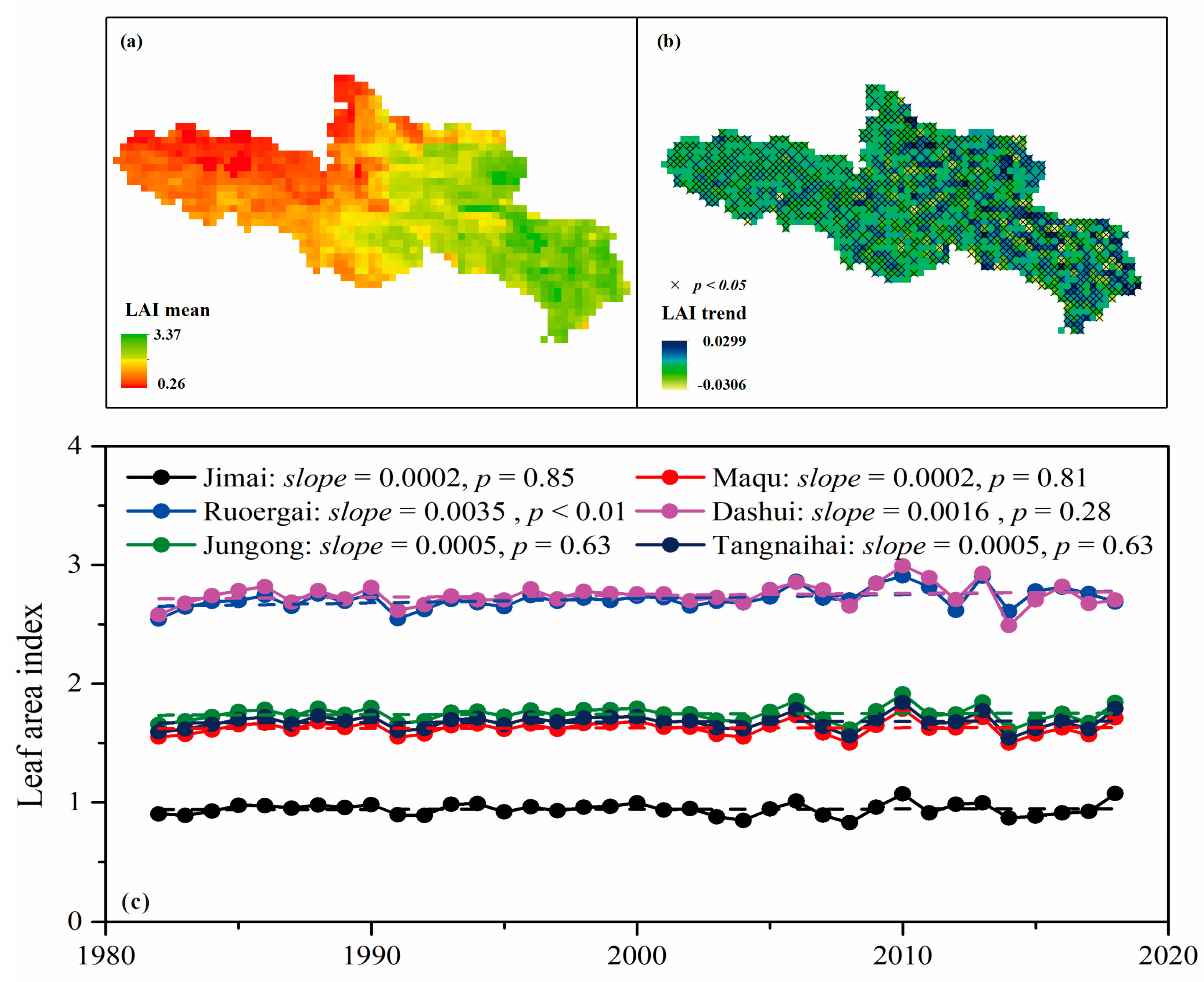

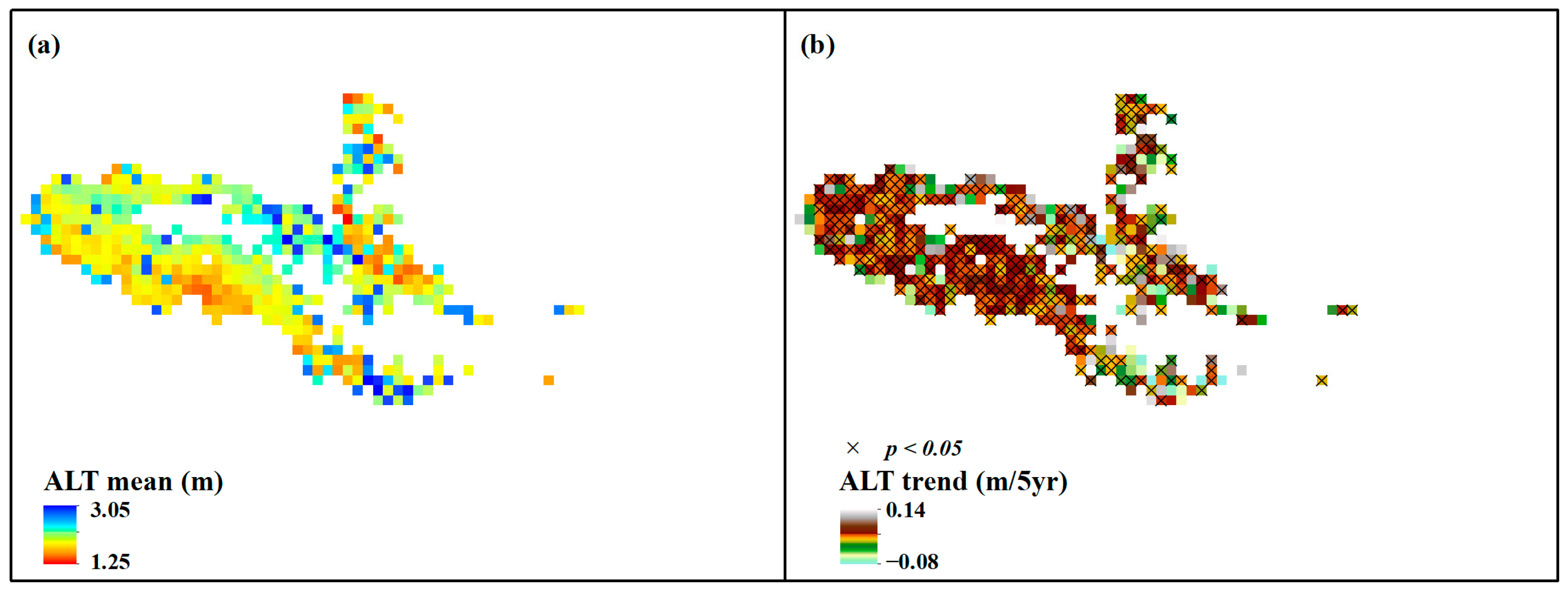
| Station | Longitude (°E) | Latitude (°N) | Catchment Area (km2) | Timespan |
|---|---|---|---|---|
| Jimai | 99.65 | 33.77 | 45,019 | 1958–2021 |
| Maqu | 102.08 | 33.97 | 86,048 | 1959–2021 |
| Jungong | 100.65 | 34.70 | 98,414 | 1980–2021 |
| Tangnaihai | 100.15 | 35.50 | 121,972 | 1956–2021 |
| Dashui | 102.27 | 33.98 | 7421 | 1984–2021 |
| Ruoergai | 102.93 | 33.60 | 4001 | 1980–2021 |
| Station | Longitude (°E) | Latitude (°N) | Timespan |
|---|---|---|---|
| Huanghe | 98.27 | 34.60 | 2006–2018 |
| Tangnaihai | 100.15 | 35.50 | 2006–2018 |
| Jungong | 100.65 | 34.70 | 2006–2018 |
| Mentang | 101.05 | 33.77 | 2006–2018 |
| Tangke | 102.47 | 33.42 | 2006–2018 |
| Longriba | 102.37 | 32.45 | 2008–2018 |
| Station | Average (108 m3) | Cv | Slope | ||||||
|---|---|---|---|---|---|---|---|---|---|
| 2000 b | 2000 a | Whole | 2000 b | 2000 a | Whole | 2000 b | 2000 a | Whole | |
| Jimai | 29.8 | 31.7 | 30.6 | 0.41 | 0.40 | 0.40 | −0.036 | 0.901 * | 0.069 |
| Maqu | 106.1 | 102.6 | 105.2 | 0.29 | 0.34 | 0.31 | −0.272 | 2.702 * | −0.031 |
| Ruoergai | 6.4 | 5.4 | 6.0 | 0.40 | 0.52 | 0.46 | −0.267 | 0.266 ** | −0.028 |
| Dashui | 7.2 | 6.5 | 6.8 | 0.40 | 0.59 | 0.51 | −0.248 | 0.381 ** | 0.038 |
| Jungong | 127.3 | 120.7 | 124.7 | 0.33 | 0.35 | 0.34 | −3.841 ** | 3.45 * | −0.222 |
| Tangnaihai | 145.7 | 145.8 | 145.8 | 0.31 | 0.33 | 0.31 | −0.126 | 3.873 * | 0.087 |
| Variable | Period | Jimai | Maqu | Ruoergai | Dashui | Jungong | Tangnaihai |
|---|---|---|---|---|---|---|---|
| Precipitation (mm/yr) | 1980–1999 | −1.96 | −3.25 * | −3.89 | −6.01 *a | −3.43 | −2.65 |
| 2000–2018 | 0.85 | 1.98 | 3.32 | 2.72 | 2.19 | 2.55 | |
| Potential evapotranspiration (mm/yr) | 1980–1999 | 1.22 | 0.96 | 0.23 | 0.45 a | 0.88 | 0.84 |
| 2000–2018 | −0.38 | −0.46 | −0.34 | −0.59 | −0.54 | −0.47 | |
| Water storage change (mm/yr) | 1980–1999 | 0.008 | −0.010 | −0.060 | −0.056 a | −0.015 | −0.020 |
| 2000–2018 | −0.074 | −0.076 | −0.096 | −0.089 | −0.074 | −0.069 | |
| Flood volume (108 m3/yr) | 1980–1999 | −0.94 | −2.89 | −0.28 ** | −0.24 a | −3.85 * | −4.39 * |
| 2000–2018 | 0.43 | 1.48 * | 0.21 * | 0.28 * | 2.24 | 2.70 |
| Basin | Period | Q (108 m3) | R (mm) | P (mm) | ET0 (mm) | ΔS (mm) | n | εP | εET0 | εΔS | εn |
|---|---|---|---|---|---|---|---|---|---|---|---|
| Jimai | 1980–1999 | 30.39 | 67.5 | 321.42 | 460.62 | 1.24 | 2.63 | 2.39 | −1.38 | −0.009 | −1.94 |
| 2000–2018 | 29.04 | 64.51 | 381.02 | 481.72 | 1.32 | 3.29 | 2.86 | −1.85 | −0.010 | −1.74 | |
| Δ | −1.35 | −2.99 | 59.6 | 21.1 | 0.08 | 0.66 | 0.47 | −0.47 | −0.001 | 0.20 | |
| Maqu | 1980–1999 | 108.13 | 125.66 | 412.90 | 484.54 | 1.47 | 2.32 | 2.03 | −1.02 | −0.007 | −1.49 |
| 2000–2018 | 94.94 | 110.34 | 438.13 | 507.63 | 1.75 | 2.71 | 2.32 | −1.31 | −0.008 | −1.48 | |
| Δ | −13.18 | −15.32 | 25.23 | 23.09 | 0.28 | 0.39 | 0.29 | −0.29 | −0.002 | 0.01 | |
| Ruoergai | 1980–1999 | 6.54 | 163.55 | 501.72 | 572.02 | 2.5 | 2.34 | 2.04 | −1.03 | −0.009 | −1.45 |
| 2000–2018 | 4.87 | 121.67 | 500.94 | 598.33 | 3.55 | 2.77 | 2.41 | −1.40 | −0.017 | −1.59 | |
| Δ | −1.68 | −41.89 | −0.78 | 26.30 | 1.05 | 0.43 | 0.37 | −0.36 | −0.007 | −0.13 | |
| Dashui | 1985–1999 | 7.30 | 98.31 | 480.47 | 566.52 | 2.06 | 3.26 | 2.81 | −1.8 | −0.011 | −1.59 |
| 2000–2018 | 5.64 | 76.00 | 489.59 | 590.91 | 3.22 | 3.77 | 3.24 | −2.22 | −0.021 | −1.71 | |
| Δ | −1.66 | −22.31 | 10.69 | 24.38 | 1.16 | 0.51 | 0.43 | −0.42 | −0.011 | −0.11 | |
| Jungong | 1980–1999 | 129.17 | 131.25 | 415.10 | 486.49 | 1.49 | 2.27 | 1.99 | −0.98 | −0.007 | −1.47 |
| 2000–2018 | 111.86 | 113.66 | 440.81 | 509.73 | 1.79 | 2.67 | 2.29 | −1.28 | −0.009 | −1.46 | |
| Δ | −17.31 | −17.59 | 25.71 | 23.24 | 0.30 | 0.41 | 0.30 | −0.30 | −0.002 | 0.01 | |
| Tangnaihai | 1980–1999 | 149.86 | 122.86 | 396.19 | 487.53 | 1.48 | 2.23 | 1.98 | −0.97 | −0.007 | −1.56 |
| 2000–2018 | 134.58 | 110.34 | 431.25 | 509.72 | 1.76 | 2.63 | 2.27 | −1.26 | −0.009 | −1.50 | |
| Δ | −15.28 | −12.53 | 35.06 | 22.19 | 0.28 | 0.40 | 0.29 | −0.29 | −0.002 | 0.06 |
Disclaimer/Publisher’s Note: The statements, opinions and data contained in all publications are solely those of the individual author(s) and contributor(s) and not of MDPI and/or the editor(s). MDPI and/or the editor(s) disclaim responsibility for any injury to people or property resulting from any ideas, methods, instructions or products referred to in the content. |
© 2025 by the authors. Licensee MDPI, Basel, Switzerland. This article is an open access article distributed under the terms and conditions of the Creative Commons Attribution (CC BY) license (https://creativecommons.org/licenses/by/4.0/).
Share and Cite
Wang, J.; Shangguan, D.; Ding, Y.; Chang, Y. Evolution and Attribution of Flood Volume in the Source Region of the Yellow River. Remote Sens. 2025, 17, 1342. https://doi.org/10.3390/rs17081342
Wang J, Shangguan D, Ding Y, Chang Y. Evolution and Attribution of Flood Volume in the Source Region of the Yellow River. Remote Sensing. 2025; 17(8):1342. https://doi.org/10.3390/rs17081342
Chicago/Turabian StyleWang, Jie, Donghui Shangguan, Yongjian Ding, and Yaping Chang. 2025. "Evolution and Attribution of Flood Volume in the Source Region of the Yellow River" Remote Sensing 17, no. 8: 1342. https://doi.org/10.3390/rs17081342
APA StyleWang, J., Shangguan, D., Ding, Y., & Chang, Y. (2025). Evolution and Attribution of Flood Volume in the Source Region of the Yellow River. Remote Sensing, 17(8), 1342. https://doi.org/10.3390/rs17081342






